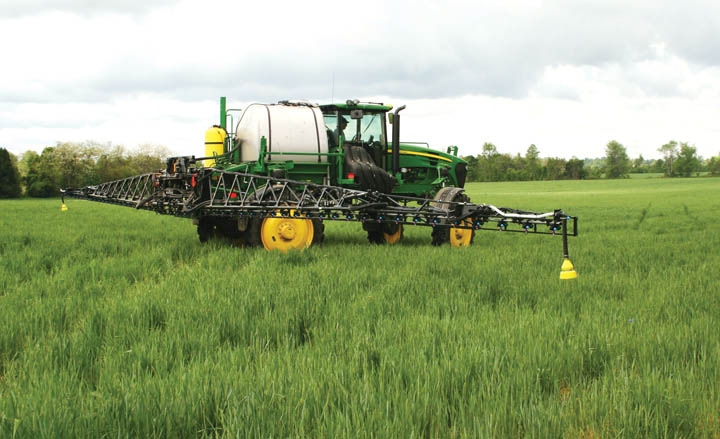December 31, 2010

Pesticide use dropped in California for a fourth consecutive year in 2009, Department of Pesticide Regulation Director Mary-Ann Warmerdam announced. Nearly 156 million pounds of pesticides were reported applied statewide, a decrease of nearly 8 million pounds - or 5 percent - from 2008.
Pesticide use in production agriculture fell by 5.1 million pounds and in most other categories as well, including post-harvest treatments, structural pest control and landscape maintenance. Reports are mandatory for agricultural and pest control business applications, while most home, industrial and institutional uses are exempt.
The Summary of Pesticide Use Report Data 2009 is posted at http://www.cdpr.ca.gov/docs/pur/pur09rep/09_pur.htm
“The winter and spring of 2009 were relatively dry, which probably resulted in less weed and disease pressure,” Warmerdam said.
“Fumigants showed the greatest drop in pounds and acres treated, which also may be due to increased environmental and regulatory concerns.”
Fumigants are gaseous pesticides injected into soil before planting to control weeds, soil-borne pests and diseases. They are primarily used on strawberry, carrot and processing tomato fields. Fumigants are also used for structural pest control of wood-destroying insects.
In 2008, DPR expanded its restrictions on agricultural fumigant applications in areas of the state that don’t meet federal air quality standards. The intent was to reduce volatile organic compound (VOC) emissions from pesticides. VOCs combine with nitrogen oxides in sunlight to form ozone, a major air pollutant.
Overall, fumigant use fell in 2009 by 5.4 million pounds, or 14 percent, and by 6,000 acres treated, or 2 percent. Use of four of the six major fumigants declined: 1,3-dichloropropene (1,3-D), potassium N-methyldithiocarbamate, metam-sodium and methyl bromide. Pounds applied of the other two fumigants, chloropicrin and sulfuryl fluoride, rose.
Insecticide use had the second largest decrease by pounds and the largest drop by acres treated. Broad-based insecticides are being replaced by newer products that target a specific pest and are less toxic to people and the environment.
Pesticide use varies from year to year depending on weather, pest problems, economics, types of crops planted and other factors. Increases and decreases in pesticide use from one year to the next or in the span of a few years do not necessarily indicate a general trend. A wet winter, for example, may result in more pesticide use to control excessive weeds.
In 2009, as in previous years, sulfur was the most highly used pesticide in both pounds applied and acres treated. By pounds, sulfur accounted for 27 percent of all reported pesticide use. It increased by 1.6 million pounds, or 4 percent, and 65,000 acres, or 1.5 percent.
Sulfur is a natural fungicide favored by both conventional and organic farmers mostly to control powdery mildew on grapes and processing tomatoes.
Major crops that showed an overall increase in pounds of pesticides applied over the previous year included processing tomatoes, wine grapes, pomegranates and pistachios. Major crops that showed an overall decline in pounds applied included carrots, table and raisin grapes, cotton, oranges and almonds. While pounds of pesticides used on almonds and oranges dropped, acres of these crops treated increased.
The top five counties in order of most pesticide pounds applied in 2009 were Fresno, Kern, Tulare, San Joaquin and Monterey. All are major producers of agricultural products.
Other details from the report show pesticide use dropped in the following categories from 2008 to 2009:
• Chemicals classified as toxic air contaminants, most of which are older compounds of high regulatory concern because of their toxicity, declined in use by 6.7 million pounds and 235,000 acres treated, or 18 percent and 8 percent, respectively.
• Chemicals classified as reproductive toxins dropped in use by 998,000 pounds and 146,000 acres treated, or 6 percent and 9 percent, respectively.
• Chemicals classified as carcinogens declined in use by 4.5 million pounds and 280,000 acres treated, or 19 percent and 8 percent, respectively.
• Chemicals classified as ground water contaminants declined in use by 182,000 pounds and 114,000 acres treated, or 14 percent and 12 percent, respectively.
• Oil pesticides declined in use by 1.7 million pounds and 126,000 acres, or 6 percent and 4 percent, respectively. Oils are used by both conventional and organic farmers mostly as insecticides and miticides in orchards.
• Cholinesterase-inhibiting pesticides continued to decline in use as they have for nearly every year since 1995. The two main classes of these pesticides are organophosphate and carbamate insecticides. From 2008 to 2009, use decreased by 881,000 pounds, or 17 percent, and 918,000 acres, or 21 percent.
DPR has the most extensive pesticide use reporting system in the United States and supports one of the most comprehensive pesticide regulatory programs in the world. These data support a variety of regulatory efforts, including compliance efforts for clean air and water laws, estimating dietary risks, protecting workers in the field, preserving endangered species, assisting product registration and review and helping local pesticide law enforcement.
You May Also Like




